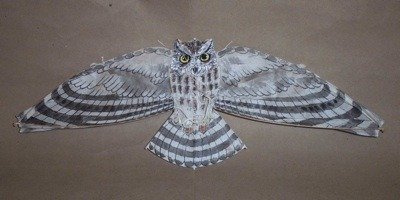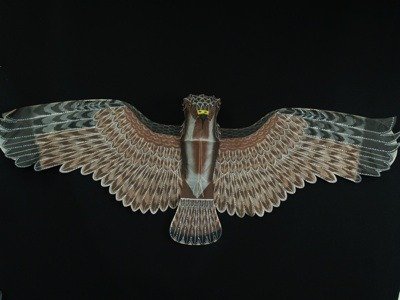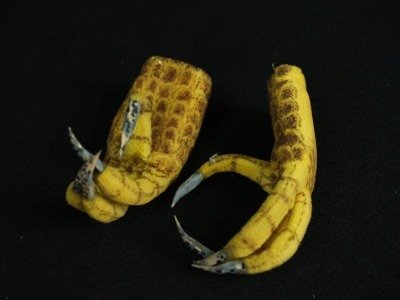A new exhibition, "Birds, Birds, Birds" has just been installed at The World Kite Museum in Long Beach, Washington. It is an exhibit of "Western" bird kites, and is quite timely. Fall bird migration is at its peak on north-south flyways across the globe, and Washington State is a major thoroughfare for birds migrating south from the Arctic.
Hearing about this exhibition spurred a look at all the kites in DF’s Collection tagged with the keyword, "bird."
Since we have over 100 bird kites in the Collection, I decided to focus this month’s feature on my favorite type of migratory bird, raptors. This term includes hawks, eagles, falcons, owls and vultures, to name a few.
A raptor is defined as a bird-of-prey with excellent eye sight and the ability to kill prey with its feet (vultures as scavengers are not always included in the classification). After graduation from college I had the privilege of working in positions where I rehabilitated wild raptors as well as brought captive birds into classrooms to teach about migration and threats to their species. On a kite-related parallel, recently DF has been working with the Alaska Wilderness League to produce and distribute bird kites to raise awareness about Arctic bird migration. You can check out the project here: http://www.alaskawild.org/countdown/
Highlighted below are four selections from our Collection of bird kites, each a different type of raptor. If you have a bird kite, let it soar and be reminded of birds’ importance to the health of our ecosystem.
IMAGE 1: Japanese Owl by Tanaka Kazue, 2007-01-K-00203 (click image for larger version)
Kazue’s small owl kite is beautifully handpainted on Washi paper. It’s mostly white body resembles the Japanese Scops Owl, similar to North America’s screech owls.
IMAGES 2 & 3: Chinese Eagle, 2007-08-K-00571 (click image for larger version)
This eagle’s realistic, detachable foam talons and protruding 3-D head make this a unique kite. Like many Chinese figure kites, the wings detach from the body and can be folded for storage.
IMAGE 4: California Condor by Stan Swanson, 2007-03-K-00288 (click image for larger version)
The California Condor is the largest of the raptors with an average ten foot wing span. It was on the brink of extinction with only 22 remaining in 1987. A captive breeding program successfully brought this bird back and with nearly 200 now living in the wild, it is regularly seen soaring over the Grand Canyon.
IMAGES 5 & 6: French Hawk, 2010-04-K-01400 (click image for larger version)
An historic French bird kite made circa 1910 from cloth. According to researcher Frits Sauve, "A hunter could use it to flush out pheasants, partridges and other birds that could be hunted down. Farmers and gardeners would use the kite to chase away birds that would eat fruit or crops." Read Frits’ full report on the French bird kite here: https://www.drachen.org/collections/report-l’aigle-dragon-numbers-1-2-3-and-4







